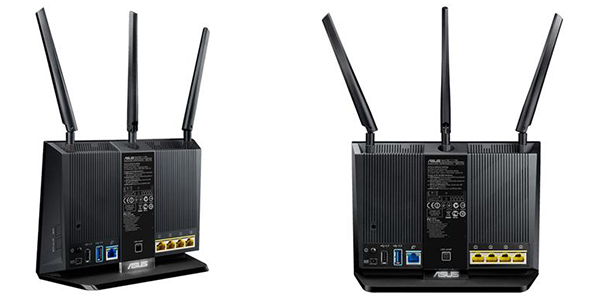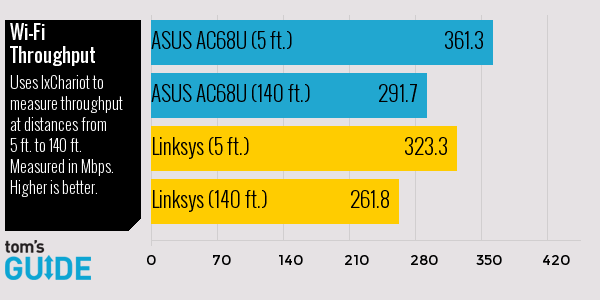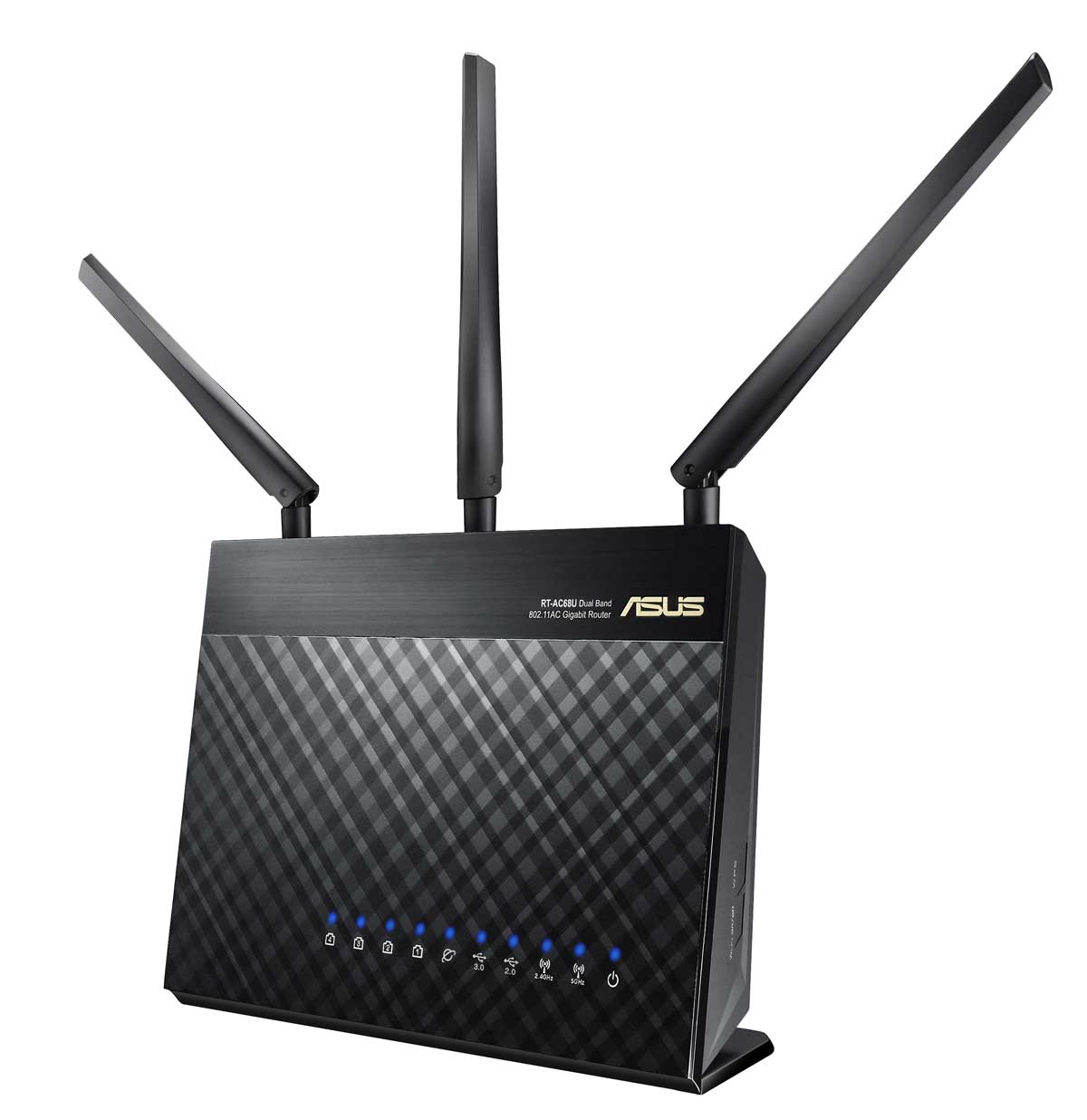Tom's Guide Verdict
A sleek design and lightning-fast speeds make the ASUS RT-AC68U the premium Wi-Fi router to beat.
Pros
- +
Fast
- +
Excellent throughput
- +
Thoughtful design
- +
Powerful firmware
- +
Easy access to files away from home
Cons
- -
Slow at 5 feet
- -
Costly cloud sync
Why you can trust Tom's Guide
ASUS' RT line of routers has developed a reputation for outstanding speeds and high quality, and the company has made significant improvements with each generation. The $219 ASUS RT-AC68U is the current result of that refining process. Its fantastic throughput means you will have no trouble razing armies in Titanfall on your Xbox, while streaming the latest Criterion release in one room and Adventure Time in another — all in 1080p. That blistering performance, an attractive chassis, and extremely customizable and easy-to-navigate firmware make this the router to beat.
Design

The ASUS RT-AC68U looks like someone took its sleek N-band brother, the RT-N66U, and stood it on its side. It's a tall, black wafer that stands upright, but with the same bright blue status lights, three 6-inch antennas and attractively textured black front that's best described as 3D plaid chic.
We like that the status lights are easy to see. We appreciate even more the easy-to-reach switch for turning off every light on the device, so that they're not distracting if the router isn't tucked away in a cabinet.
MORE: Best Wi-Fi Boosters
The body of the router is small, but the three prominent antennas add considerably to its height. The ASUS measures 12 x 8.5 x 3.2 inches. The router has a smaller footprint than the Linksys WRT1900AC's 11.5 x 8 x 5 inches, but the ASUS' prodigious height could limit its placement.
Setup
The ASUS Quick Internet Setup helpfully pops up on any device attached to the router via Wi-Fi or Ethernet and guides you through a simple setup procedure. You create an SSID, connect to the Internet and you're off.
I especially like that the guide insists that you properly secure the router with a Wi-Fi password. In fact, after disregarding this note, I was bemused to find that eight other people logged into the router in our office building.
Get instant access to breaking news, the hottest reviews, great deals and helpful tips.
Firmware
Very little has changed in the last few iterations of the ASUS RT router firmware. It's an easy-to-navigate interface with an attractive, blue-gray color palette. Major settings are well-labeled and readily accessible.
The first page you see when you log on is a particularly handy Network Map that can tell you at a glance which devices are attached to the router.
The RT-AC68U has one of the most customizable vanilla firmwares I've come across, with settings that are extremely comparable to those found in custom firmwares such as OpenWRT and Tomato. Diving into the Advanced Settings allowed me to fine-tune the built-in firewall with DDoS protection and a number of filters, ranging from URLs to keywords to Network Services. In other words, you can keep Facebook, Tumblr or adult-only content off of your network.
AiCloud

The AiCloud mobile app for Android and iOS is ASUS' method of accessing a local network while away from home. Compared with similar apps from other manufacturers, the iOS version of AiCloud is joyfully simple to use.
After installing AiCloud on my iPhone, all I had to do to have permanent remote access to my network was open the app while on my local Wi-Fi. This was much easier than on Linksys' app, which requires you to create a username and password and log into the router.
Yes, the app's user interface is outdated, and there aren't many settings to tweak, but I did get immediate and hassle-free access to both my Mac and Windows servers.
AiCloud has three aspects: Cloud Disk lets you access USB devices attached to the router; Smart Access provides access to shared files on your local network, and Smart Sync allows you to create your own Dropbox-like service on your network.
Cloud Disk and Smart Access are both simple tools that simply work. Smart Sync, however, requires an ASUS Web-storage account and a monthly fee. It also has a limit of 10GB on daily downloads and a file upload size limit of 10GB. However, paying $23 per year for 100GB of storage is quite reasonable. Dropbox has none of the limitations of ASUS but costs $99 per year for 100GB.
MORE: Hubs, Switches and Routers: What's the Difference?
Performance

Due to the reputation of the ASUS RT line, I expected good things from the RT-AC68U, but the speeds it managed absolutely blew me away. The RT-AC68U is the fastest router we've tested on both AC and N bands at nearly every distance.
Using IxChariot and a laptop with an Intel 2 x 2 AC Wi-Fi chip, the RT-AC68U hit a category best 108.8 Mbps at 15 feet on the N band. That's a whopping 30 Mbps faster than both the average and the Linksys WRT1900AC.
The RT-AC68U is also blisteringly fast on the AC band at 15 feet. Its 346.1 Mbps was well above the category average of 319.2 Mbps and more than 20 Mbps faster than the WRT1900AC's mark of 321.6 Mbps.

HERE
Things were even better at 50 feet on the AC band, where the ASUS was one of only two routers tested to crack 300Mbps. Its throughput of 302.8 Mbps was also nearly 70 Mbps better than the category average of 233.8 Mbps and 50Mbps better than the WRT1900AC's showing of 251.5Mbps.
The RT-AC68U's crowning achievement was its throughput at 140 feet on the AC band. At 291.7 Mbps, the ASUS was 30 Mbps faster than the WRT1900AC and a blazing 80 Mbps faster than the category average of 211.2 Mbps.
Ironically, the only distance at which the RT-AC68U stumbled was 5 feet, where its 74.9 Mbps on the N band was neck and neck with the category average of 73.7Mbps and 10Mbps behind the $249 Linksys WRT1900AC's showing. It's possible that the N-band signal is so strong at 5 feet that it actually crowds the band.
Bottom Line

For $220, the ASUS RT-AC68U offers the fastest speeds we've yet seen from a router, a svelte design and simple but powerful firmware. We also like that you can access your important files remotely via the AiCloud app. Those who want to install custom firmware may prefer the $240 Linksys WRT1900AC, but power users looking for great throughput should buy the RT-AC68U.
- Best PC Antivirus Software
- Our Favorite Streaming Media Players
- The Scariest Security Threats Headed Your Way
-
tteksystems With the most recent release of Routers, such as this ASUS-AC68U, and the Netgear Nighthawk R7000, the initial reviews seemed to favor these 2 routers, but I saw several recommendations for the Netgear Nighthawk. That was earlier this year. Now, I see the ASUS-AC68U is just wiping the floor with the latest reviews, as if it was suddenly a new animal. I mean, initial reviews did not give it this much praise and the Nighthawk was almost always mentioned in reviews when determining which is the best choice.Reply
I was just wondering if AC technology is still a little buggy or can it be considered just as stable as some of the highly renowned N routers. I use the term stable and I guess what I want to know is if this ASUS router will keep me connected consistently. My household seems to be having a lot of random disconnects from the router I am currently using, but I've never experienced this until recently. I really thought my current router was mighty stable. I'm using the Netgear AC6300. I was using the AC6200 Wireless Adapter by Netgear for a long time. There is one thing that I changed recently though. I installed an ASUS AC56 AC1300 USB3 Wireless Adapter. I have great signal all the time. But why all the sudden random disconnections when pairing the ASUS AC adapter with my Netgear Router? Anyone know if it is more stable to pair like brands? Meaning, is it more stable if I use the ASUS brand AC Router with ASUS brand AC Network Adapters? I was curious because my Netgear AC Adapter seemed pretty flawless for quite some time. I wish I still had it to see if maybe it too would be having these connection drops. The things that baffles me about these types of problems is that I have absolutely perfect signal on both bands. And the other issue with this ASUS adapter is that the 5Ghz band craps out on me with the slowest download speeds and I have to unplug it and change to a different USB3 port for it to regain the download speeds I get from my ISP. I do not use the ASMEDIA USB3 ports because they always seem unstable for devices that are plugged in constantly. I use them to hot plug a USB3 thumb drive for files but not much else.
I have to buy this ASUS router here. I think there is not much to lose. It's more updated than my version 1 Netgear R6300 and I have to figure it should pair nicely with my ASUS Adapter. I really like ASUS. I also like the Netgear. But sometimes it's like hit or miss with these super fast network devices. Some people just cannot say enough good things about a specific brand and model while a dozen others post that they would never again buy one or recommend it to anyone due to bad results dealing with them.
Well, I have lots of ASUS hardware, I cannot say anything bad about the performance either. They have become a super giant in the computer hardware industry -
schalliol It looks like you only reviewed using a 2 x 2 NIC. Is that correct? If so, you didn't evaluate the 3 x 3 performance…Reply -
jaytmoon just shot in the dark but with your AC1300, do you have power savings disabled in the device's properties?Reply -
Matt2h I'm deciding between this router and the ASUS RT-AC87. This router's form fits my space, but I'm thinking about MU-MIMO. How valuable is it? With a few devices going at once, will I see significant improvement on a MU-MIMO router vs. one like this? I have no more than 50 mbps down from my ISP anyway, but I want efficient utilization and am willing to consider future-proofing (I know MU-MIMO *clients* are just starting to be rolled out, but as one article noted, any MU-MIMO you can run clears frees up more bandwidth for everyone else, including the single input output devices).Reply


